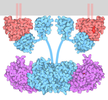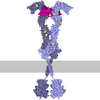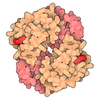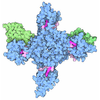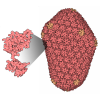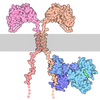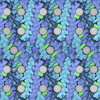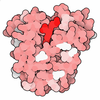+ Open data
Open data
- Basic information
Basic information
| Entry | Database: PDB / ID: 9nwe | |||||||||
|---|---|---|---|---|---|---|---|---|---|---|
| Title | E3 ligase UBR4-KCMF1-calmodulin complex | |||||||||
 Components Components |
| |||||||||
 Keywords Keywords | LIGASE / E3 ligase / UBR4 / ISR | |||||||||
| Function / homology |  Function and homology information Function and homology informationnegative regulation of HRI-mediated signaling / synaptic signaling / ubiquitin-dependent protein catabolic process via the N-end rule pathway / protein K27-linked ubiquitination / cytoplasm protein quality control by the ubiquitin-proteasome system / protein branched polyubiquitination / negative regulation of fatty acid biosynthetic process / endosome organization / cytoplasm protein quality control / protein K11-linked ubiquitination ...negative regulation of HRI-mediated signaling / synaptic signaling / ubiquitin-dependent protein catabolic process via the N-end rule pathway / protein K27-linked ubiquitination / cytoplasm protein quality control by the ubiquitin-proteasome system / protein branched polyubiquitination / negative regulation of fatty acid biosynthetic process / endosome organization / cytoplasm protein quality control / protein K11-linked ubiquitination / CaM pathway / Cam-PDE 1 activation / Sodium/Calcium exchangers / Calmodulin induced events / positive regulation of ryanodine-sensitive calcium-release channel activity / Reduction of cytosolic Ca++ levels / Activation of Ca-permeable Kainate Receptor / CREB1 phosphorylation through the activation of CaMKII/CaMKK/CaMKIV cascasde / Loss of phosphorylation of MECP2 at T308 / CREB1 phosphorylation through the activation of Adenylate Cyclase / CaMK IV-mediated phosphorylation of CREB / PKA activation / negative regulation of high voltage-gated calcium channel activity / Glycogen breakdown (glycogenolysis) / CLEC7A (Dectin-1) induces NFAT activation / Activation of RAC1 downstream of NMDARs / organelle localization by membrane tethering / negative regulation of ryanodine-sensitive calcium-release channel activity / mitochondrion-endoplasmic reticulum membrane tethering / autophagosome membrane docking / negative regulation of calcium ion export across plasma membrane / regulation of cardiac muscle cell action potential / presynaptic endocytosis / Synthesis of IP3 and IP4 in the cytosol / regulation of cell communication by electrical coupling involved in cardiac conduction / Phase 0 - rapid depolarisation / calcineurin-mediated signaling / Negative regulation of NMDA receptor-mediated neuronal transmission / Unblocking of NMDA receptors, glutamate binding and activation / RHO GTPases activate PAKs / Ion transport by P-type ATPases / Uptake and function of anthrax toxins / regulation of ryanodine-sensitive calcium-release channel activity / tertiary granule membrane / ficolin-1-rich granule membrane / Long-term potentiation / protein phosphatase activator activity / Calcineurin activates NFAT / Regulation of MECP2 expression and activity / DARPP-32 events / protein K63-linked ubiquitination / catalytic complex / Smooth Muscle Contraction / detection of calcium ion / regulation of cardiac muscle contraction / RHO GTPases activate IQGAPs / regulation of cardiac muscle contraction by regulation of the release of sequestered calcium ion / protein K48-linked ubiquitination / calcium channel inhibitor activity / specific granule membrane / cellular response to interferon-beta / presynaptic cytosol / Protein methylation / Activation of AMPK downstream of NMDARs / Ion homeostasis / regulation of release of sequestered calcium ion into cytosol by sarcoplasmic reticulum / eNOS activation / titin binding / Tetrahydrobiopterin (BH4) synthesis, recycling, salvage and regulation / sperm midpiece / voltage-gated potassium channel complex / regulation of calcium-mediated signaling / calcium channel complex / positive regulation of autophagy / substantia nigra development / FCERI mediated Ca+2 mobilization / Ras activation upon Ca2+ influx through NMDA receptor / regulation of heart rate / FCGR3A-mediated IL10 synthesis / adenylate cyclase activator activity / calyx of Held / Antigen activates B Cell Receptor (BCR) leading to generation of second messengers / protein serine/threonine kinase activator activity / VEGFR2 mediated cell proliferation / sarcomere / regulation of cytokinesis / VEGFR2 mediated vascular permeability / Translocation of SLC2A4 (GLUT4) to the plasma membrane / spindle microtubule / positive regulation of receptor signaling pathway via JAK-STAT / RAF activation / Transcriptional activation of mitochondrial biogenesis / RING-type E3 ubiquitin transferase / Stimuli-sensing channels / cellular response to type II interferon / long-term synaptic potentiation / response to calcium ion / RAS processing / spindle pole / Signaling by RAF1 mutants Similarity search - Function | |||||||||
| Biological species |  Homo sapiens (human) Homo sapiens (human) | |||||||||
| Method | ELECTRON MICROSCOPY / single particle reconstruction / cryo EM / Resolution: 3.2 Å | |||||||||
 Authors Authors | Yang, Z. / Rape, M.P. | |||||||||
| Funding support |  United States, 2items United States, 2items
| |||||||||
 Citation Citation |  Journal: Nature / Year: 2025 Journal: Nature / Year: 2025Title: Molecular basis of SIFI activity in the integrated stress response. Authors: Zhi Yang / Diane L Haakonsen / Michael Heider / Samuel R Witus / Alex Zelter / Tobias Beschauner / Michael J MacCoss / Michael Rapé /    Abstract: Chronic stress response activation impairs cell survival and causes devastating degenerative diseases. Organisms accordingly deploy silencing factors, such as the E3 ubiquitin ligase silencing factor ...Chronic stress response activation impairs cell survival and causes devastating degenerative diseases. Organisms accordingly deploy silencing factors, such as the E3 ubiquitin ligase silencing factor of the integrated stress response (SIFI), to terminate stress response signalling and ensure cellular homeostasis. How a silencing factor can sense stress across cellular scales to elicit timely stress response inactivation is poorly understood. Here we combine cryo-electron microscopy analysis of endogenous SIFI with AlphaFold modelling and biochemical studies to report the structural and mechanistic basis of the silencing of the integrated stress response. SIFI detects both stress indicators and stress response components through flexible domains within an easily accessible scaffold, before building linkage-specific ubiquitin chains at separate, sterically restricted elongation modules. Ubiquitin handover by a ubiquitin-like domain couples versatile substrate modification to linkage-specific ubiquitin polymer formation. Stress response silencing therefore exploits a catalytic mechanism that is geared towards processing many diverse proteins and therefore allows a single enzyme to monitor and, if needed, modulate a complex cellular state. #1:  Journal: Biorxiv / Year: 2024 Journal: Biorxiv / Year: 2024Title: The molecular basis of integrated stress response silencing Authors: Yang, Z. / Haakonsen, D.L. / Heider, M. / Witus, S.R. / Zelter, A. / Beschauner, T. / MacCoss, M.J. / Rape, M. | |||||||||
| History |
|
- Structure visualization
Structure visualization
| Structure viewer | Molecule:  Molmil Molmil Jmol/JSmol Jmol/JSmol |
|---|
- Downloads & links
Downloads & links
- Download
Download
| PDBx/mmCIF format |  9nwe.cif.gz 9nwe.cif.gz | 818.8 KB | Display |  PDBx/mmCIF format PDBx/mmCIF format |
|---|---|---|---|---|
| PDB format |  pdb9nwe.ent.gz pdb9nwe.ent.gz | 584.3 KB | Display |  PDB format PDB format |
| PDBx/mmJSON format |  9nwe.json.gz 9nwe.json.gz | Tree view |  PDBx/mmJSON format PDBx/mmJSON format | |
| Others |  Other downloads Other downloads |
-Validation report
| Summary document |  9nwe_validation.pdf.gz 9nwe_validation.pdf.gz | 1.5 MB | Display |  wwPDB validaton report wwPDB validaton report |
|---|---|---|---|---|
| Full document |  9nwe_full_validation.pdf.gz 9nwe_full_validation.pdf.gz | 1.6 MB | Display | |
| Data in XML |  9nwe_validation.xml.gz 9nwe_validation.xml.gz | 120.3 KB | Display | |
| Data in CIF |  9nwe_validation.cif.gz 9nwe_validation.cif.gz | 180.3 KB | Display | |
| Arichive directory |  https://data.pdbj.org/pub/pdb/validation_reports/nw/9nwe https://data.pdbj.org/pub/pdb/validation_reports/nw/9nwe ftp://data.pdbj.org/pub/pdb/validation_reports/nw/9nwe ftp://data.pdbj.org/pub/pdb/validation_reports/nw/9nwe | HTTPS FTP |
-Related structure data
| Related structure data |  49876MC  9d9zC  9nwdC C: citing same article ( M: map data used to model this data |
|---|---|
| Similar structure data | Similarity search - Function & homology  F&H Search F&H Search |
- Links
Links
- Assembly
Assembly
| Deposited unit | 
|
|---|---|
| 1 |
|
- Components
Components
| #1: Protein | Mass: 577180.938 Da / Num. of mol.: 2 / Source method: isolated from a natural source / Source: (natural)  Homo sapiens (human) / Cell line: HEK293T Homo sapiens (human) / Cell line: HEK293TReferences: UniProt: Q5T4S7, RING-type E3 ubiquitin transferase #2: Protein | Mass: 16852.545 Da / Num. of mol.: 2 / Source method: isolated from a natural source / Source: (natural)  Homo sapiens (human) / References: UniProt: P0DP23 Homo sapiens (human) / References: UniProt: P0DP23#3: Protein | Mass: 41992.348 Da / Num. of mol.: 2 / Source method: isolated from a natural source / Source: (natural)  Homo sapiens (human) Homo sapiens (human)References: UniProt: Q9P0J7, RING-type E3 ubiquitin transferase #4: Chemical | ChemComp-ZN / #5: Chemical | ChemComp-CA / Has ligand of interest | N | Has protein modification | Y | |
|---|
-Experimental details
-Experiment
| Experiment | Method: ELECTRON MICROSCOPY |
|---|---|
| EM experiment | Aggregation state: PARTICLE / 3D reconstruction method: single particle reconstruction |
- Sample preparation
Sample preparation
| Component | Name: Human E3 ubiquitin ligase UBR4-KCMF1-calmodulin complex (Silencing Factor of ISR, SiFI) Type: COMPLEX / Entity ID: #1-#3 / Source: NATURAL |
|---|---|
| Molecular weight | Value: 1.27 MDa / Experimental value: YES |
| Source (natural) | Organism:  Homo sapiens (human) Homo sapiens (human) |
| Buffer solution | pH: 7.5 |
| Specimen | Conc.: 3.6 mg/ml / Embedding applied: NO / Shadowing applied: NO / Staining applied: NO / Vitrification applied: YES |
| Specimen support | Grid material: COPPER / Grid mesh size: 300 divisions/in. / Grid type: Quantifoil R1.2/1.3 |
| Vitrification | Instrument: FEI VITROBOT MARK IV / Cryogen name: ETHANE / Humidity: 100 % / Chamber temperature: 283.15 K |
- Electron microscopy imaging
Electron microscopy imaging
| Experimental equipment |  Model: Titan Krios / Image courtesy: FEI Company |
|---|---|
| Microscopy | Model: TFS KRIOS |
| Electron gun | Electron source:  FIELD EMISSION GUN / Accelerating voltage: 300 kV / Illumination mode: FLOOD BEAM FIELD EMISSION GUN / Accelerating voltage: 300 kV / Illumination mode: FLOOD BEAM |
| Electron lens | Mode: BRIGHT FIELD / Nominal defocus max: 2000 nm / Nominal defocus min: 800 nm |
| Image recording | Electron dose: 40 e/Å2 / Film or detector model: GATAN K3 BIOQUANTUM (6k x 4k) |
- Processing
Processing
| CTF correction | Type: PHASE FLIPPING ONLY |
|---|---|
| 3D reconstruction | Resolution: 3.2 Å / Resolution method: FSC 0.143 CUT-OFF / Num. of particles: 87263 / Symmetry type: POINT |
 Movie
Movie Controller
Controller






 PDBj
PDBj









